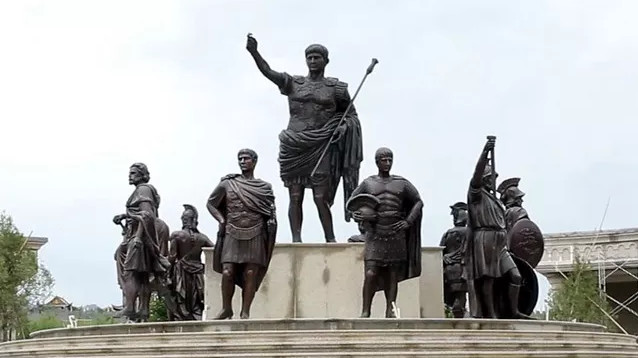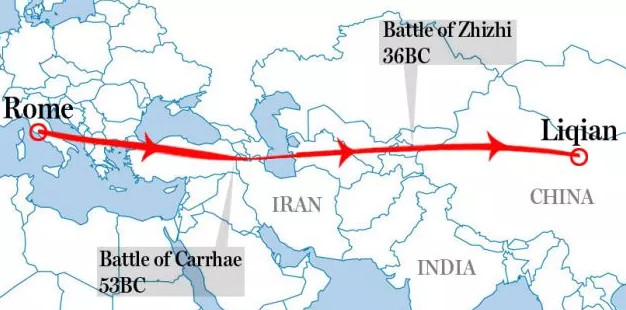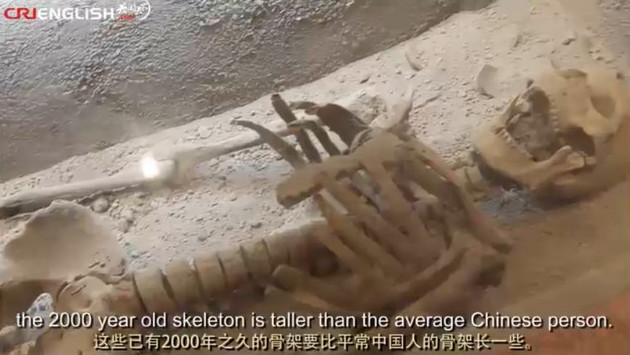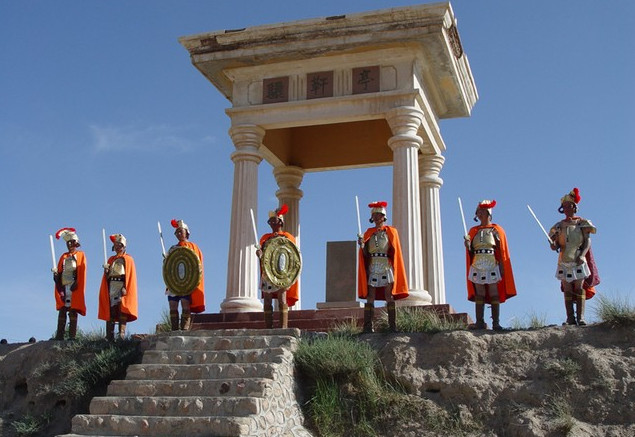Li Jian, a small Chinese village, is nothing special except ancient Roman structures, statues of Roman celebrities, and blond, blue-eyed villagers dressed in Roman soldier costumes.
Did the ancient Roman soldiers conquer as far as China?
On the edge of the Gobi Desert, in Vinh Xuong District, Kim Xuong Town, Gansu Province, PRC, is a village called Li Jian. An isolated village, nothing special. With the exception of ancient Roman structures, statues of Roman celebrities, and blond, blue-eyed villagers dressed in Roman soldier costumes.

Li Jian Village is located on the land that was once Li Jian Town. It wouldn’t be special if the people here looked like all Chinese – but no: hooked nose, white skin, blonde hair, blue eyes, these are the traits you can notice in Li Jian’s people. These are the characteristics of the Caucasoid race – the “white” race – clearly not of indigenous peoples. Homer Hasenpflug Dubs – Oxford professor of Chinese studies, translator of the English translation of the Chinese book – advanced in 1941 a theory that is controversial to this day that the city of Li Jian was founded by the Romans.
What prompted you to come up with such a daring hypothesis? First, we have to consider some strange coincidences in the historical developments when Li Jian was established in the Han Dynasty.
1. The name of the trial
From the Late Han Shu and many other documents, we know that the Han Chinese were known to the Roman Empire and gave Rome at least three names: Dai Qin, which implied that Roman was the China of the West, Hai Tay – the West of the Great Sea, and Li Jian (or Le Kien). Is it just a coincidence, or, according to Professor Dubs’ theory, in fact the village of Li Jian and the Roman Empire were linked?
2. Time of establishment
The city of Li Jian appears on the map in AD 5, but is not recorded in AD 79. In the west of the continent, in 53 BC, the Roman army under the command of Marcus Licinius Crassus was defeated by the Parthians at the Battle of Carrhae. Many have been arrested, others have fled and are unknown. According to Professor Dubs, in the period that followed, perhaps Roman soldiers wandered east (on the run or after being freed by the Parthians). They become mercenaries for the Huns, and lead to a third coincidence: the battle of Taraz in 36 BC.
3. Battle of Taraz, 36 BC
In 36 BC, in present-day Talas, Kazakhstan, there was a fierce battle between the Han army and the Huns under the leadership of Zen vu Chi Chi, which ended in the victory of the Han dynasty. Specifically, Han Thu mentioned 145 trained soldiers in the Hungarian army, fighting with the “fish scale formation” – a formation that Professor Dubs thought was in fact the famous Testudo formation of the army. He assumed that these soldiers were mercenaries of Roman origin and, after falling into the hands of the Han people, were transferred to the east to form the city of Li Jian.

“Always avoid unnecessary complications” – William of Ockham’s motto in solving situations is called lex parsimoniae or “Ockham razor”. By explaining the cause of things, it means that the simpler the assumptions, the more plausible the assumptions and the less likely it is that the assumption has irrelevant coincidences. According to lex parsimoniae, the simple and plausible hypothesis was that of Professor Dubs, that the inhabitants of Li Jian were in fact the descendants of the defeated Romans.
A skeleton up to 1.8m tall was found during the excavation of the relic of the ancient city of Li Jian – an unusual height for a Chinese resident. This skeleton dates back around 2000 years, coinciding with the time of the creation of the city, and therefore also coinciding with Professor Dubs’ hypothesis. There are also some interesting details such as: the graves here all face west, the people of Li Jian also often organize some form of “bullfight” – for 2 bulls to fight to the death – a hobby. The controller has the “Roman” part.

However, genetic research among residents of Li Jian and archeology, for decades, with the association of archaeologists from many places, most recently a link between Italy and China, still cannot provide. convincing evidence for Professor Dubs’ hypothesis. Research shows that 56% of the population carry the gene for the Caucasoid strain, but it is impossible to determine whether it is the word “Roman” or not. Ethnicity. There is no notion of “Roman people”).
On the Silk Road and in the steppes of Central Asia, as well as in the nomadic armies of the region, whites were not uncommon. Another study in 2007 found that 77% are closely related to indigenous people, mostly Han Chinese. So far, no specific monument to Roman soldiers has been found in the area. However, there was no evidence to disprove Professor Dubs’ hypothesis and the controversy continued.

Meanwhile, residents and authorities in Li Jian have found a new source of income from curious tourists.


